The structure of a plant root. Features of the structure of the root
Living organisms are studied by the science of biology. The structure of the plant root is considered in one of the sections of botany.
The root is the axial vegetative organ of the plant. It is characterized by unlimited apical growth and radial symmetry. Features of the structure of the root depend on many factors. This is the evolutionary origin of the plant, its belonging to a particular class, habitat. The main functions of the root include plant strengthening in the soil, participation in vegetative propagation, storage and synthesis of organic nutrients. But the most important function that ensures the vital activity of a plant organism is soil nutrition, which is carried out in the process of active absorption of water containing dissolved mineral salts from the substrate.
Root types
The external structure of the root is largely determined by what type it belongs to.
- main root. Its formation occurs from the germinal root, when the seed of the plant begins to germinate.
- adventitious roots. They can appear on various parts of the plant (stem, leaves).
- Lateral roots. It is they who form branches, starting from previously appeared roots (main or adventitious).
Types of root systems
The root system is the totality of all the roots that a plant has. At the same time, the appearance of this aggregate in different plants can vary greatly. The reason for this is the presence or absence, as well as varying degrees of development and severity of different types of roots.
Depending on this factor, several types of root systems are distinguished.
- The name speaks for itself. The main root acts as a pivot. It is well defined in size and length. The structure of the root according to this type is typical for This is sorrel, carrots, beans, etc.
- This type has its own characteristics. The external structure of the root, which is the main one, is no different from that of the lateral ones. It doesn't stand out in the crowd. Formed from the germinal root, it grows for a very short time. The urinary root system is characteristic of monocotyledonous plants. These are cereals, garlic, tulip, etc.
- Root system of mixed type. Its structure combines the features of the two types described above. The main root is well developed and stands out against the general background. But at the same time, adventitious roots are also strongly developed. Typical for tomato, cabbage.
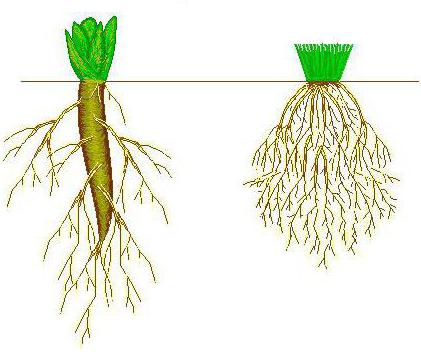
Historical development of the root
From the point of view of the phylogenetic development of the root, its appearance occurred much later than the formation of the stem and leaf. Most likely, the impetus for this was the emergence of plants on land. In order to gain a foothold in a solid substrate, the representatives of the ancient flora needed something that could serve as a support. In the process of evolution, root-like underground branches first formed. Later they gave rise to the development of the root system.
root cap
The formation and development of the root system is carried out throughout the life of the plant. The structure of the plant root does not provide for the presence of leaves and buds. Its growth is carried out by increasing in length. At the point of growth, it is covered with a root cap.
The growth process is associated with educational tissue. It is she who is under the root cap, which performs the function of protecting delicate dividing cells from damage. The case itself is a collection of thin-walled living cells in which the renewal process is constantly taking place. That is, when the root moves in the soil, the old cells gradually exfoliate, and new ones grow in their place. Also located on the outside of the cells of the cap secrete a special mucus. It facilitates the advancement of the root in a solid soil substrate.
It is well known that depending on the habitat, the structure of plants varies greatly. For example, aquatic plants do not have a root cap. In the process of evolution, they formed another adaptation - a water pocket.
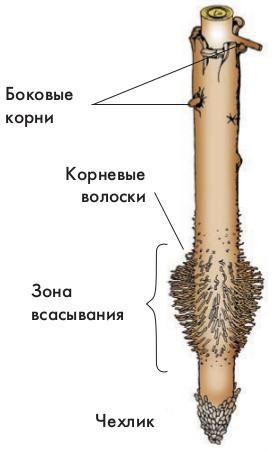
Plant root structure: division zone, growth zone
Cells, emerging from over time, begin to differentiate. Thus, root zones are formed.
division zone. It is represented by cells of the educational tissue, which subsequently give rise to all other types of cells. The zone size is 1 mm.
Growth zone. It is represented by a smooth area, the length of which is from 6 to 9 mm. Follows immediately after the division zone. Cells are characterized by intensive growth, during which they are strongly elongated, and gradual differentiation. It should be noted that the division process in this zone is almost not carried out.
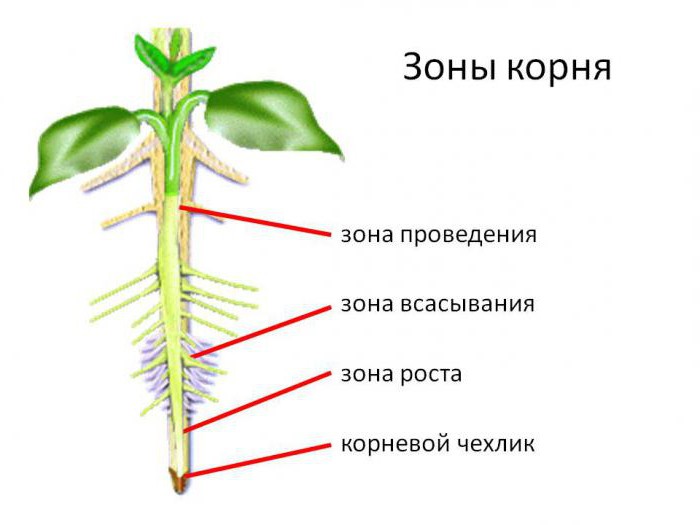
Suction zone
This area of the root, several centimeters long, is also often referred to as the root hair zone. This name reflects the structural features of the root in this area. There are outgrowths of skin cells, the size of which can vary from 1 mm to 20 mm. These are the root hairs.
The suction zone is a place where active absorption of water, which contains dissolved minerals, takes place. The activity of root hair cells, in this case, can be compared with the work of pumps. This process is very energy intensive. Therefore, the cells of the absorption zone contain a large number of mitochondria.
It is very important to pay attention to one more feature of the root hairs. They are able to secrete a special mucus containing carbonic, malic and citric acids. Mucus promotes the dissolution of mineral salts in water. Due to the mucus, soil particles seem to stick to the root hairs, facilitating the absorption of nutrients.
The structure of the root hair
The increase in the area of the suction zone occurs precisely due to the root hairs. For example, their number in rye reaches 14 billion, forming a total length of up to 10,000 kilometers.
The appearance of the root hairs makes them look like a white fluff. They do not live long - from 10 to 20 days. It takes very little time for the formation of new ones in a plant organism. For example, the formation of root hairs in young seedlings of an apple tree is carried out in 30-40 hours. The area where these unusual outgrowths died off can absorb water for some time, and then a cork covers it, and this ability is lost.
If we talk about the structure of the hair shell, then, first of all, we should highlight its subtlety. This feature helps the hair to absorb nutrients. Its cell is almost completely occupied by a vacuole surrounded by a thin layer of cytoplasm. The core is located at the top. The space near the cell is a special mucous membrane that promotes gluing of root hairs with small particles of the soil substrate. This increases the hydrophilicity of the soil.
The transverse structure of the root in the suction zone
The zone of root hairs is also often called the zone of differentiation (specialization). This is no coincidence. It is here that a certain layering can be seen in the cross section. It is due to the delimitation of layers within the root.
The table "The structure of the root in the cross section" is presented below.
It should be noted that there is also a distinction within the cortex. Its outer layer is called the exoderm, the inner one is the endoderm, and between them is the main parenchyma. It is in this intermediate layer that the process of directing nutrient solutions into the vessels of the wood takes place. Also, some organic substances vital for the plant are synthesized in the parenchyma. Thus, the internal structure of the root makes it possible to fully assess the significance and importance of the functions that each of the layers performs.
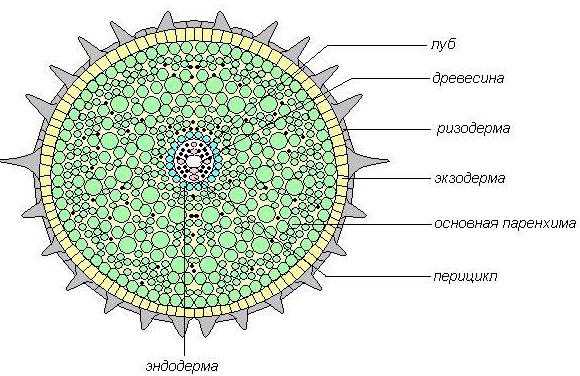
Venue
Located above the suction zone. The largest in length and the most durable section of the root. It is here that the movement of substances important for the life of the plant organism takes place. This is possible due to the good development of conductive tissues in this zone. The internal structure of the root in the conduction zone determines its ability to transport substances in both directions. The ascending current (upward) is the movement of water with mineral compounds dissolved in it. And organic compounds are delivered down, which are involved in the vital activity of root cells. The conduction zone is the place where lateral roots are formed.
The structure of the bean sprout root clearly illustrates the main steps in the process of plant root formation.
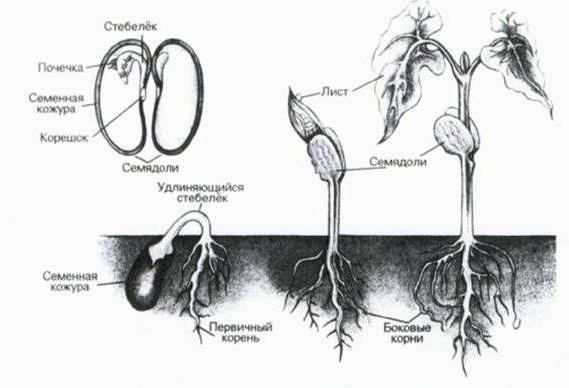
Features of the structure of the root of the plant: the ratio of ground and underground parts
Many plants are characterized by such a development of the root system, which leads to its predominance over the ground part. An example is cabbage, the root of which can grow 1.5 meters deep. Its width can be up to 1.2 meters.
It grows so much that it occupies a space whose diameter can reach 12 meters.
And in the alfalfa plant, the height of the ground part does not exceed 60 cm. Whereas the length of the root can be more than 2 meters.
All plants that live in areas with sandy and rocky soils have very long roots. This is due to the fact that in such soils water and organic matter are very deep. In the process of evolution, plants adapted to such conditions for a long time, the structure of the root gradually changed. As a result, they began to reach the depth where the plant organism can stock up on the substances necessary for growth and development. So, for example, the root can be 20 meters deep.
Root hairs in wheat branch so strongly that their total length can reach 20 km. However, this is not the limit. Unrestricted apical root growth in the absence of strong competition with other plants can increase this value several times more.
Root modifications
The structure of the root of some plants can change, forming the so-called modifications. This is a kind of adaptation of plant organisms in specific habitat conditions. Below is a description of some of the modifications.
Root tubers are characteristic of dahlia, chistyak and some other plants. Formed by thickening of adventitious and lateral roots.
Ivy and campsis also differ in the structural features of these vegetative organs. They have so-called trailing roots, which allow them to cling to nearby plants and other supports that are within their reach.
Characterized by a large length and sucking up water, monstera and orchids have.
Respiratory roots growing vertically upward are involved in the function of respiration. There are brittle willows.
Vegetable crops such as carrots, beets, radishes have roots that were formed due to the growth of the main root, inside which nutrients are stored.
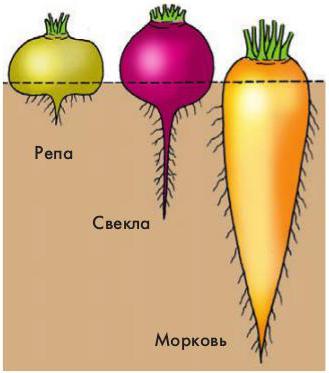
Thus, the structural features of the plant root, leading to the formation of modifications, depend on many factors. The main ones are habitat and evolutionary development.







